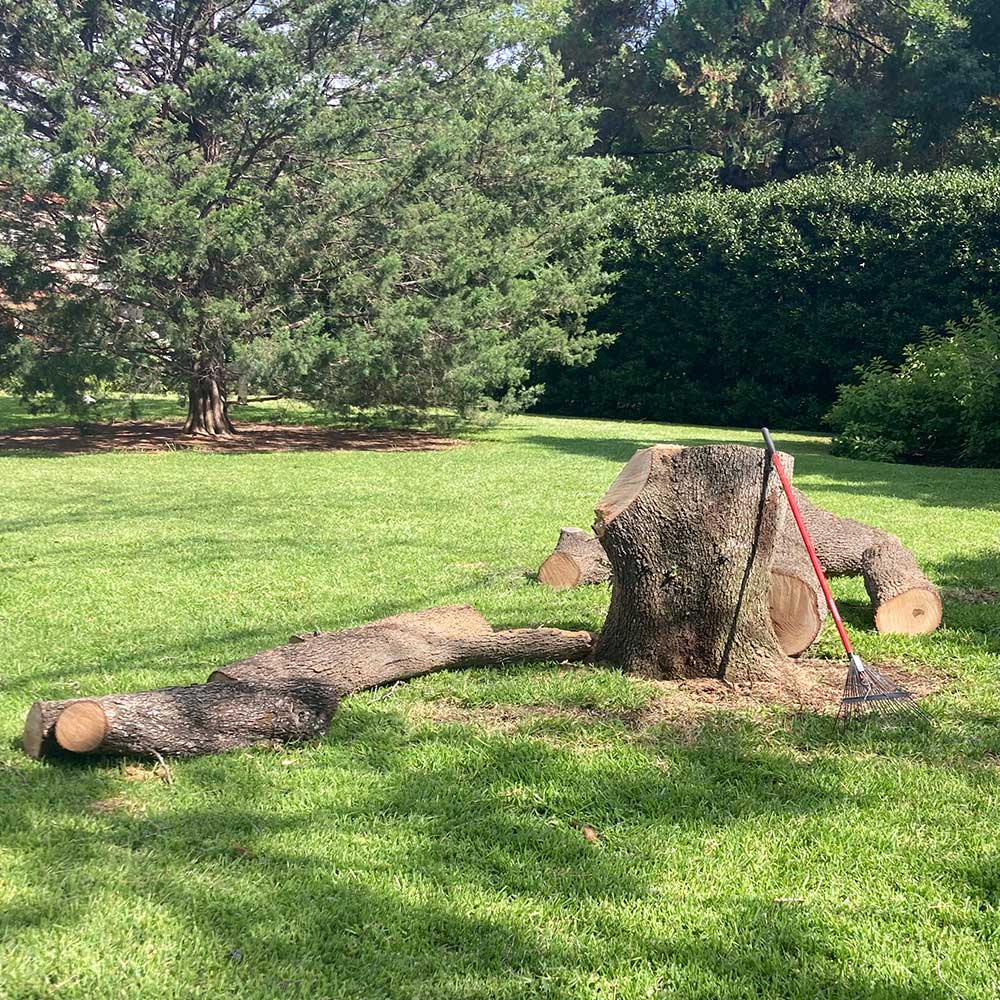If you’re planning to remove a tree, picking up a random weekend won’t do. The timing matters more than most people think. In Fort Worth, our weather, tree species, and even local laws affect when it’s smart, or even legal, to take down a tree.
Cut it at the wrong time, and you risk spreading disease around your yard, higher costs, and extra stress on your landscape. Cut it at the right time, and it’s safer, easier, and typically cheaper.
Here’s the short answer: late fall to early winter is usually the best time for tree removal in Fort Worth. That’s when trees are dormant, pests are low, and permits are easier to manage.
Keep reading to find out why that window makes such a big difference.
Why Timing Matters for Tree Removal in Fort Worth
Let’s start with why timing is a critical factor when removing a tree. Picking the right season helps your property, your wallet, and the health of your landscape.
1. Dormant Season Helps Everything Go Smoother
Trees slow down in late fall and winter. That means less sap, no leaves, and no active growth. It’s the safest time to cut without stressing out the tree or the surrounding plants.
2. Less Risk of Pests and Disease
Cut a tree during warm months, and pests or fungi can jump in fast. Oak wilt is a big concern in Fort Worth. That’s why we avoid cutting oaks in spring and summer.
3. Easier Access for Crews
When the ground is dry and trees don’t have heavy foliage, the tree removal crew can work faster and safer. They can see the structure clearly and use equipment without tearing up your lawn.
4. You Might Save Money
Winter is often slower in the tree care business. That means better availability and sometimes better prices. It’s also easier to plan the job around your schedule, which isn’t always possible during storm season.
5. Less Stress on Trees That Stay
If you’re removing one tree near others, timing matters. Removing trees during dormancy causes less impact to nearby root systems and makes it easier for them to recover.
6. Avoid Oak Wilt Season
Oak trees are very sensitive. You should only cut or remove them in winter (usually January to February) to avoid oak wilt. This deadly fungus spreads fast through cuts made in the wrong season.
7. Faster Recovery for Your Yard
Your soil and landscape will bounce back quicker in cooler months. It’s because there’s no baking sun, no heat stress on nearby plants, and fewer bugs to deal with.
Seasonal Breakdown: Pros & Cons for Tree Removal
You don’t want to waste time or money. So let’s break down what each season means for tree removal in Fort Worth.
1. Winter: Best Time
This is your best window to bring down a tree. Trees are dormant during the winter, with no leaves or pests. The crews you hire can see what they’re doing, which means faster and safer work.
Why it works:
- Trees are asleep, so removal doesn’t stress them or nearby plants.
- Visibility is better without leaves.
- Less sap means less mess.
- No risk of oak wilt or any other tree diseases.
2. Fall: Also a Good Time
Fall is a solid second choice. You can beat the rush before winter storms hit. As trees start slowing down, it’s easier to remove them.
Why it works:
- Fewer leaves to deal with.
- You get ahead of winter weather.
- Better visibility for crews.
3. Spring: Not Great
Trees are in full growth mode during spring. Cutting now puts them under stress and may attract pests. Some birds also nest in trees this time of year, and yes, that matters when removing one.
Why it’s not ideal:
- New growth means trees are full of sap.
- Risk of oak wilt and other diseases.
- Protected bird nests can delay or block removal.
4. Summer: Worst Time
This is the season to avoid if you can. It’s hot, the trees are full, and local tree experts are busy with storm cleanups. Your job may take longer and cost more during this season.
Why it’s tough:
- Full leaf cover makes it harder to work.
- Heat slows everything down.
- More pests and diseases.
- Less schedule flexibility.
If you want smooth, simple, and safe removal, late fall or winter is your best window for tree removal in Fort Worth. Of course, every season has its trade-offs, but not all are worth it.
Don’t Ignore Permits for Tree Removal
Before you cut down a tree in Fort Worth, make sure you know the rules. It’s not always as simple as grabbing a saw and getting started.
Some trees are protected by city regulations. Froth Worth has the strongest tree protections in the state. In April 2025, the city council expanded its list of protected trees from 26 to 47 species in addition to stricter forestry preservation rules.
If your tree is large, healthy, or part of a heritage species, you may need a permit for removal. Fort Worth has size thresholds and zoning laws that affect what you can and can’t remove. If your tree is over a certain trunk diameter or located within a protected area, the city might require an inspection or written approval.
If you live in a neighborhood with a homeowners’ association (HOA), there may be additional rules to follow. Some HOAs require advance notice or even formal approval for tree removal, especially if the tree is visible from the street or near property lines.
Removing a tree without the right permit can lead to steep fines or delays. That’s why it’s always smart to check city and HOA rules first. You don’t want to spend time or money on a tree removal only to find out it wasn’t allowed. Always confirm the legal side before moving forward.
Think about Which Tree Species You Want to Remove
Not all trees are the same, and timing matters even more depending on the species in your yard. Some trees in Fort Worth need extra care when it comes to removal.
1. Oak Trees
Oaks are highly vulnerable to oak wilt, which spreads through fresh cuts. You should only remove or prune oak trees during dormancy, typically January and February. Cutting at the wrong time could infect your other trees and kill them.
2. Pecan Trees
Pecan trees are easier to handle once their leaves drop. The best time to remove a pecan tree is between November and February, before new buds form.
3. Crape Myrtles
These are easier to cut back or remove while dormant. Try to avoid pruning or removing crape myrtles in late spring when new growth starts. That puts stress on the tree and ruins its bloom cycle.
4. Ash Trees
Ash trees in Fort Worth are at risk of infestation by the Emerald Ash Borer. If you see signs of damage, like canopy thinning or bark splits, you may need to act fast. Timing depends on the level of infestation, so it’s best to get a professional check right away.
How Tree Health Affects Timing
Sometimes, you can’t wait for the “best” season, especially if the tree is in bad shape. If your tree is leaning, cracking, or dropping limbs, that’s a red flag. Trees with visible damage, hollow trunks, or dead branches can fall without warning. Waiting for the right season could put your home or family at risk.
Disease and pests can also affect damaged trees more quickly. If you notice signs like fungus at the base, oozing sap, or unusual leaf loss, your tree might already be unstable. In that case, you should take it down as soon as possible.
Storm season in Fort Worth makes things even riskier. High winds and heavy rain can bring down weak or damaged trees. If your tree was hit in a storm, get it inspected by tree care experts and remove it as early as you can.
Ready to Remove a Tree? Let’s Make It Safe and Simple.
Late fall to early winter is typically the best time to take down a tree on your Fort Worth property. If you’re removing it for landscaping, wait for the right season and sort all permits out first. But you don’t have to wait for the right time to remove a damaged or diseased tree.
If you’ve got a tree that needs to go, call Fort Worth Arborist Co. We’ll handle it the right way, on time, by the book, and with zero mess left behind. Call 817-975-0180 or reach out online to schedule your tree removal request.
Frequently Asked Questions
1. What month is best for tree removal in Fort Worth?
The best months are November through February. Trees are dormant, pests are inactive, and your arborists will have better access.
2. Can I remove a tree myself?
You can, but it’s risky. Tree removal requires special equipment and training. One wrong move can damage your home, yard, or hurt someone. It’s always safer to hire a certified arborist.
3. Do I need a permit to cut down a tree on my property?
In Fort Worth, you might. If the tree is large or part of a protected species, you may require a permit. Check with the city or call us, and we’ll help you figure it out.
4. What’s the average cost of tree removal in Fort Worth?
Costs vary based on size, location, and condition of the tree. Most removals fall between $300 and $2,000. Call us for a free quote.
5. Will insurance cover tree removal after a storm?
If the tree caused damage to your home or blocked access, your insurance might help. But we recommend speaking with your provider for exact details.
6. When is the cheapest time to remove a tree in Fort Worth?
Late fall and winter are usually the most affordable times. This is when arborists have more availability, and their rates may be lower.
7. Is tree removal cheaper in winter?
Yes, winter means fewer leaves, less cleanup, and easier access. That typically means faster jobs and lower costs.
8. Why are trees removed in the dormant season?
Dormant trees don’t bleed sap, attract fewer pests, and are easier to cut without harming surrounding plants.
9. What trees require special timing in North Texas?
Oaks should only be cut in winter to avoid oak wilt. Pecans, crape myrtles, and ash trees also have ideal windows for safe removal. Always ask before you cut.

